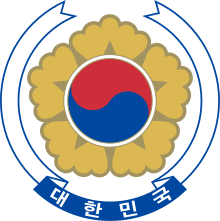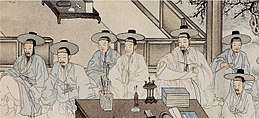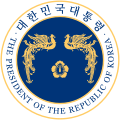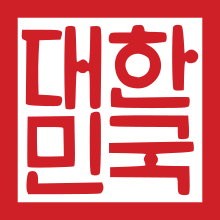Emblem of South Korea
The National Emblem of the Republic of Korea (Korean: 대한민국의 국장; Hanja: 大韓民國의 國章, lit. 'Republic of Korea national emblem') consists of the taeguk symbol present on the South Korean national flag surrounded by five stylized petals and a ribbon bearing the inscription of the official Korean name of the country (Daehan Minguk), in Korean characters. The Taegeuk represents peace and harmony. The five petals all have meaning and are related to South Korea's national flower, the Hibiscus syriacus, or Rose of Sharon (Korean: 무궁화; Hanja: 無窮花, mugunghwa).
| National Emblem of the Republic of Korea 대한민국의 국장 | |
|---|---|
 | |
| Armiger | Republic of Korea |
| Adopted | 10 December 1963 (modified in 1997) |
| Blazon | A Taegeuk gules and azure upon a Hibiscus syriacus or Korean rose, with a banner surrounding it, saying Republic of Korea in Korean. |
| Motto | 대한민국 |
 |
| Part of a series on the |
| Culture of Korea |
|---|
| History |
|
Festivals |
|
|
Music and performing arts |
|
Media
|
|
|
Monuments
|
|
National symbols of Korea
|
The emblem was adopted on 10 December 1963.[1][2][3] The flower and yin-yang symbols are generally considered by South Koreans to be traditional symbols of the "Korean race" (Korean: 한민족, lit. '"Han race"').[3]
Gallery
.svg.png) Emblem of South Korea, 1948–1963
Emblem of South Korea, 1948–1963.svg.png) National seal (1949–1962)
National seal (1949–1962).svg.png) Emblem of South Korea, 1963–1997
Emblem of South Korea, 1963–1997.svg.png) National seal (1963–1999)
National seal (1963–1999) Seal of the President, with two phoenixes facing each other over a rose of Sharon.
Seal of the President, with two phoenixes facing each other over a rose of Sharon. Emblem of the Prime Minister. A rose of Sharon enclosed by another.
Emblem of the Prime Minister. A rose of Sharon enclosed by another. Emblem of the National Assembly. The word "국회" meaning 'National Assembly' (gukhoe / 國會 in Hanja) appears in Korean characters in the center of a rose of Sharon.
Emblem of the National Assembly. The word "국회" meaning 'National Assembly' (gukhoe / 國會 in Hanja) appears in Korean characters in the center of a rose of Sharon..svg.png) National seal (1999–2008, 2010–2011)
National seal (1999–2008, 2010–2011).svg.png) National seal (2008–2010)
National seal (2008–2010) National seal (2011–present)
National seal (2011–present) Emblem of the National Government, a stylized Taeguk (2017–present)
Emblem of the National Government, a stylized Taeguk (2017–present) South Korean passport
South Korean passport
See also
- Flag of South Korea
- Emblem of North Korea
- Imperial Seal of Korea, uses plum blossom instead
- Taegeuk
References
- Ministry of the Interior of the Republic of Korea (2017). National Symbols of the Republic of Korea: Uniting People and Elevating National Pride. Seoul: Ministry of the Interior of the Republic of Korea. pp. 10–11. Archived from the original on 2017-08-06. Retrieved 6 August 2017.
- https://mois.go.kr/chd/sub/a05/mascot/screen.do
- Myers, Brian Reynolds (2011). "North Korea's state-loyalty advantage". Free Online Library. Archived from the original on 20 May 2018. Retrieved 20 May 2018.
The state emblem (adopted in 1963) is a yin-yang symbol on a rose of Sharon--another purely racial symbol.